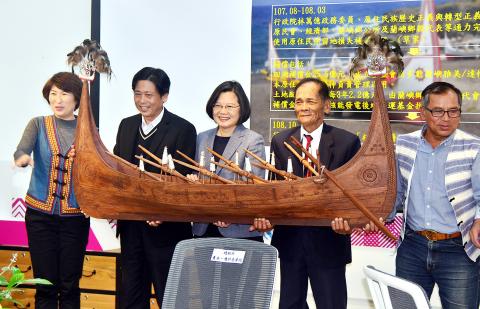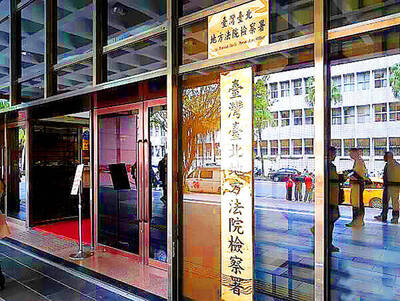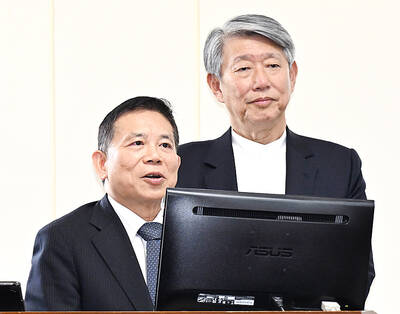The Ministry of Economic Affairs yesterday announced that the Tao community of Orchid Island (Lanyu, 蘭嶼) would receive NT$2.55 billion (US$83.6 million) in compensation after a government investigation found that they were unaware of plans to create the Lanyu nuclear waste disposal facility.
Ministry officials made the announcement at a news conference in Taitung attended by President Tsai Ing-wen (蔡英文).
The investigation “discovered the truth” and the compensation fulfills part of the government’s Aboriginal transitional justice project, Tsai said.

Photo: CNA
Tsai in 2016 instructed Minister Without Portfolio Lin Wan-i (林萬億) to launch the investigation after receiving a complaint from Lanyu residents.
The probe found that the Tao community was not notified that the government was planning to establish the facility, the ministry said.
The compensation is to be disbursed under the Regulations on Development and Management of the Lands Reserved for Indigenous People (原住民保留地開發管理辦法), it said.
The funds would not be provided all at once, but rather in annual installments of NT$25 million, it added.
Lanyu Township Mayor Chiaman Chialamu said that residents were happy to hear the decision.
“Out of all the presidents who have visited Lanyu, only President Tsai listened,” Chiaman said.
However, he said that while the compensation is welcome, the nuclear waste must be removed from the island.
The township would select a board to oversee a foundation governing the funds, Chiaman said, adding that their use would require majority approval by residents.
Separately yesterday, Executive Yuan spokeswoman Kolas Yotaka said that “today’s compensation has historic meaning for both the Executive Yuan and Lanyu.”
It is the first step toward finding historical truth and compensating Lanyu residents, she said.
The Executive Yuan yesterday exhibited declassified documents showing that in the 1970s, then-premiers Chiang Ching-kuo (蔣經國) and Sun Yun-hsuan (孫運璿) approved plans to build the facility and store nuclear waste on Lanyu without residents’ consent.
Additional reporting by Huang Pei-chun

Intelligence agents have recorded 510,000 instances of “controversial information” being spread online by the Chinese Communist Party (CCP) so far this year, the National Security Bureau (NSB) said in a report yesterday, as it warned of artificial intelligence (AI) being employed to generate destabilizing misinformation. The bureau submitted a written report to the Legislative Yuan in preparation for National Security Bureau Director-General Tsai Ming-yen’s (蔡明彥) appearance before the Foreign Affairs and National Defense Committee today. The CCP has been using cognitive warfare to divide Taiwanese society by commenting on controversial issues such as Taiwan Semiconductor Manufacturing Co’s (TSMC, 台積電) investments in the

INVESTIGATION: The case is the latest instance of a DPP figure being implicated in an espionage network accused of allegedly leaking information to Chinese intelligence Democratic Progressive Party (DPP) member Ho Jen-chieh (何仁傑) was detained and held incommunicado yesterday on suspicion of spying for China during his tenure as assistant to then-minister of foreign affairs Joseph Wu (吳釗燮). The Taipei District Prosecutors’ Office said Ho was implicated during its investigation into alleged spying activities by former Presidential Office consultant Wu Shang-yu (吳尚雨). Prosecutors said there is reason to believe Ho breached the National Security Act (國家安全法) by leaking classified Ministry of Foreign Affairs information to Chinese intelligence. Following interrogation, prosecutors petitioned the Taipei District Court to detain Ho, citing concerns over potential collusion or tampering of evidence. The

‘COMPREHENSIVE PLAN’: Lin Chia-lung said that the government was ready to talk about a variety of issues, including investment in and purchases from the US The National Stabilization Fund (NSF) yesterday announced that it would step in to staunch stock market losses for the ninth time in the nation’s history. An NSF board meeting, originally scheduled for Monday next week, was moved to yesterday after stocks plummeted in the wake of US President Donald Trump’s announcement of 32 percent tariffs on Taiwan on Wednesday last week. Board members voted to support the stock market with the NT$500 billion (US$15.15 billion) fund, with injections of funds to begin as soon as today. The NSF in 2000 injected NT$120 billion to stabilize stocks, the most ever. The lowest amount it

NEGOTIATIONS: Taiwan has good relations with Washington and the outlook for the negotiations looks promising, Minister of Economic Affairs J.W. Kuo said Taiwan’s GDP growth this year is expected to decrease by 0.43 to 1.61 percentage points due to the effects of US tariffs, National Development Council (NDC) Minister Paul Liu (劉鏡清) said at a meeting of the legislature’s Economics Committee in Taipei yesterday, citing a preliminary estimate by a private research institution. Taiwan’s economy would be significantly affected by the 32 percent “reciprocal” tariffs slapped by the US, which took effect yesterday, Liu said, adding that GDP growth could fall below 3 percent and potentially even dip below 2 percent to 1.53 percent this year. The council has commissioned another institution